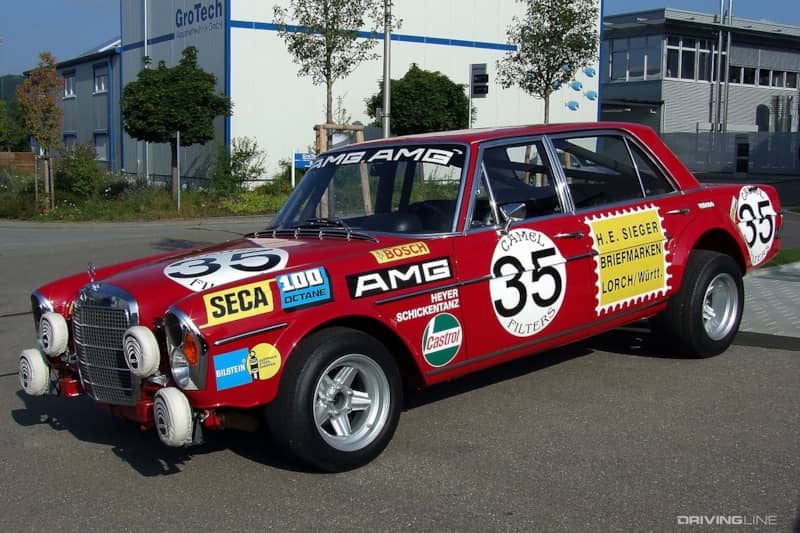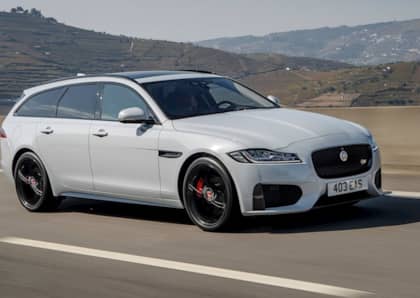10 Least Likely and Weird Race Cars of All Time
Sometimes, racing gets weird. In a high stakes world where every possible competitive advantage is sought out, bending the rules of a particular series can result in unusual-looking race car designs that defy convention, and in many cases, the boundaries of good taste. At the same time, budgetary restrictions have also contributed their fair share of bizarrely wonderful oddballs to the grid, threatening the status quo and shaking up expectations among fans and competitors alike.
In celebration of racing's ability to surprise, we've put together this gathering of some of the least likely vehicles ever to make it to the start/finish line. See how many of these misfits you may have heard of.
1. Cadillac Le Monstre

It might be hard to believe, but sitting underneath that outrageous (for the time) bodywork is a 1949 Cadillac Series 61. The story goes like this: Briggs Cunningham was invited to lead the first American team to compete in the 24 Hours of Le Mans, and he decided to bring two cars with him. The first was a factory-spec manual-equipped Series 61 coupe, while the other was mechanically nearly identical to its sibling but had its body entirely replaced with an experimental shell developed in a wind tunnel.
Dubbed "Le Monstre" or "The Monster" by the French, the car featured a 331 ci V8 fed by five carburetors, and it ran an eventful race, burying itself into a sandbank at one point and requiring Cunningham to leave the driver's seat and dig it out. Le Monstre finished 11th, while the standard Cadillac coupe finished 10th, and the team secured a return invitation to compete the following year.
2. Chaparral 2J

It's a simple story, really: If downforce is so important to sticking a race car to the track, why rely on passive aerodynamics when you can use active aero to generate it even while sitting still? So went the philosophy behind the Chaparral 2J, Jim Hall's final wacky sand-kick into the face of Can-Am scrutineers.
The refrigerator-shaped race car was built around a pair of giant fans at the rear of the car that were themselves powered by a two-stroke engine. A maximum of 1.5 G of downforce was available from the setup regardless of what velocity it was traveling, a stark contrast to traditional aero cars that required high speeds to grip the ground. Quick, but never reliable, eventually the vehicle was banned by the SCCA based on fairly nebulous complaints from other teams.
3. Lada Granta

Lada has long been a punch line for American auto enthusiasts, but the Russian brand continues to forge ahead not just with street cars in Europe, but also the occasional attempt to score points in the World Touring Car Championship. One of its latest entries is the Lada Granta WTCC, a sedan that first competed in 2012. It featured a turbocharged four-cylinder engine pushing out a whopping 380hp. Lada ran several Grantas in WTCC, finishing respectably well in a number of races and putting the automaker in points contention during the 2014 season.
4. Citroen ID 19

A racing Citroen might not sound all that weird given the French company's long and distinguished history, but what if we told you that this particular model, the ID 19, ran in a NASCAR race? A pair of the front-wheel drive imports ran at Riverside, California in 1958 as part of the Crown America 500, finishing inside the top 20 despite their middling 70hp engines. It was a different type of NASCAR than what we're used to in the modern era, but the idea of a French competitor was still considered enough of a joke 50 years later when Talladega Nights used it as a primary plotline, indicating just how unusual this cross-cultural pollination truly was.
5. Volvo 850 Wagon BTCC
The year was 1994. Volvo, intent on drawing attention to its return to racing in British Touring Car Championship, made the startling realization that its 850 wagon body was really no worse aerodynamically than that of the 850 sedan. The decision was made to use the estate version of the car, which was significantly larger than any other entry in the series, had a much higher center of gravity and was prone to lifting two wheels through tight corners—much to the delight of BTCC photographers, who happily provided Volvo with the kind of media coverage they coveted. The pair of 290hp, turbocharged five-cylinder five-doors would finish 14th and 15th, respectively, in their only season of competition.
6. Mercedes-Benz 300 SEL AMG

As unusual as a wagon was in touring car competition in the '90s, it was equally weird for sports car fans to show up at a track in the early 1970s and see a limousine turning in hot lap after hot lap. So it went with the Mercedes-Benz 300 SEL AMG "Rote Sau" or "Red Pig," a brightly-painted full-size sedan that weighed a ton but still did more than a ton down the straights of Spa in its first 24 hour race there in 1971.
Featuring an enormous 6.8L V8 engine that was double that, or more, of any other car lined up beside it, the car's 428hp and 448 lb-ft of torque sped it to second place overall at its inaugural event. Sometimes, more is more.
7. Toyota Prius GT

Here's what you need to know about the Toyota Prius GT race car:
- Yes, it's still a hybrid.
- But one that's centered around a mid-mounted V8 engine that produces 300hp.
- It ran from 2012 to 2018, snagging the podium several times.
- Why can't NASCAR be this cool?
8. Tyrell P34

One look at the Tyrell P34 and it's easy to see why F1 fans were shocked when it appeared on the scene in 1976. Designed to fit a pair of smaller front wheels behind the front wing and improve the car's slipperiness through the air, the P34's other advantage was increased braking area spread over six wheels rather than four. Jody Scheckter won the Swedish Grand Prix that same year, with his teammate Patrick Depailler coming in second, but the following season saw significantly less success for the design, and it was retired after the 1977 campaign.
9. Rolls-Royce Corniche

If you're going to run the famously grueling Paris to Dakar rally, why not do it in style? That seems to have been the argument behind Thierry de Montcorgé's 1981 entry to the event, a Rolls-Royce Corniche coupe body mounted on a Toyota Land Cruiser chassis and powered by a 5.7L small block Chevy V8.
Initially perceived as a joke, the desert Rolls made it as high as 13th in the standings before being disqualified for an illegal roadside repair. The car, named Jules, still finished the race despite not being officially placed.
10. Jungle Jim's Chevrolet Vega Wagon

For a brief period, wagons enjoyed a surge of interest in NHRA's Pro Stock class due in part to the traction-adding extra mass distributed above the rear wheels as compared to a sedan or a coupe. Of these, one of the most unusual was "Jungle" Jim Lieberman's 1972 Chevrolet Vega, a car more vilified for its econo roots than celebrated for its performance prowess. Still, the Vega's ability to accept a V8 under its hood, combined with its stubby wheelbase and lightweight design, made it a force to be reckoned with down the quarter mile.











